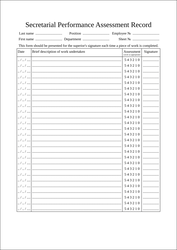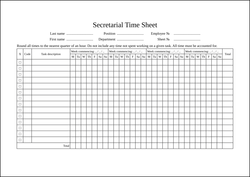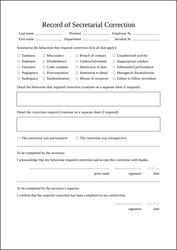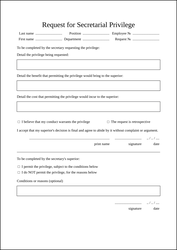he's the secretary
Appendix
In chapter three, we considered various ways in which forms can add realism to your role-play. Creating such paperwork is a straightforward task for a sissy secretary, especially if he's permitted to use authentic documents as a reference. Here, we present some examples of what a man might achieve with a modicum of effort, showing how even relatively simple forms can be effective. Of course, these forms are by no means as complicated as they could be, but they nevertheless offer plenty of possibilities, regardless of whether you're just fooling around or taking things more seriously. If you'd like to use any of these forms yourself, they can be downloaded using the links below - the PDF format is suitable for printing, whereas the RTF format can be edited in most word processors.
Secretarial Performance Assessment Record
Despite its grandiose title, the form shown in Figure A.1 is actually a very simple affair. After a header that requests basic details about the secretary, each of the lines prompts for a date and a brief description, then provides a six-point scale for assessment and a space for a signature. You might split the task of completing it between the two of you, expecting your secretary to fill in the first half so as to leave you only needing to circle a number, or you might decide to summarise his work yourself, providing further opportunity to humble him. Either way, it won't take more than a few moments of your time, no matter how long he might have spent typing, but woe betide your secretary should his efforts not make the grade!
Following the rubric, you might have your secretary present the form after every piece of work, or alternatively, you might use it to keep a record of his performance each day over the course of a number of weeks. Even if you have a significant sheaf of such forms, it's still easy to take in the numbers at a glance, allowing patterns or outliers to be observed. Knowing that his performance is going to be recorded for perpetuity will encourage your secretary to make an effort, all the more so if you make a habit of looking back through such a record on a regular basis. Depending on how frequently he disappoints you, you might remark that “This isn't the first time you've fallen short of my expectations recently”, or alternatively, “You haven't let me down like this for quite a while” - both sure to motivate him to do better in future!
Secretarial Time Sheet
Compared to the previous form, the time sheet in Figure A.2 is a far more complicated affair. The countless little boxes are unlikely to be something you would want to consider yourself, but are ironically capable of occupying a sissy secretary for a surprising amount of time, especially if you have him complete them retrospectively. You might even have your husband account for everything he's done when not working as your secretary, requiring him to rack his brains long before he worries about the form's more cryptic parts. What should be put in the column that prompts for codes, and under what circumstances should he tick the boxes that are marked only with an unhelpful X? That's entirely up to you to decide, and for him to find out - albeit perhaps not until after he's filled things in wrongly!
You don't have to take a form like this too seriously in order to have fun with it - simply having your secretary fill it in with random numbers can be provocative, it proving surprisingly challenging for a man to do so plausibly! Even in a real office, time sheets are often simply made up, but that doesn't mean they can be treated with the disdain such administrative annoyances generally deserve. A single mistake, if not merely your whim, can be grounds for having your secretary write everything out again, or you could have him collate four weekly sheets into a single one. You might alternatively waste his time by telling him to enter the data into a corresponding spreadsheet, or to produce a handwritten version of numbers on a screen, to be filed away somewhere where it will never be looked at again - assuming you don't interrupt such make-work with more important demands!
Record of Secretarial Correction
Whether you're punishing your secretary playfully, or seeking to correct him more seriously, the form shown in Figure A.3 allows him to consider both the causes and the consequences. The form starts with a similar header to the previous ones, prompting for the misbehaving man's name and details - something that can be chastening for him to have to write down in the context of an impending punishment, regardless of whether or not he adopts a different persona. Following that, there's a series of boxes to summarise what he has or hasn't done, with the precise distinction offering plenty of potential for catching your secretary out if you leave that to him. What exactly is the difference between “Negligence” and “Inattention to detail”, for example? Ticking the wrong one could be enough for you to rip up a form and have him start again, assuming you'd rather not complete this section yourself, perhaps insisting that your secretary fill it in as you dictate. The box that follows can be treated similarly, again requiring a man to consider his actions. Does he really understand what he has done wrong, or will he need to fill out yet another form before he appreciates the full extent of his failings?
Expecting your secretary to present a half-completed form so that you can add the details of how you're going to discipline him is a great way of stressing his submission, but the effectiveness of such paperwork doesn't stop there - it then requires his signature, not only having him acknowledge the need for correction, but also express thanks for it. Last, but by no means least, there's a space for you to declare that you consider his correction to have been satisfactorily completed, providing closure no matter what might happen in between. While such a form can be used to add spice to the sort of sexually charged discipline we discussed in chapter four, its wording also makes it suitable for more mundane corrections - indeed, you might have your secretary complete such paperwork simply because a first draft of a report needed further work!
Request for Secretarial Privilege
The form shown in Figure A.4 provides a way for your secretary to seek your permission in a formalised way, but its design is such as to require him to consider more than his own desires. Again, the form begins with our standard header, but of the three boxes that follow, two prompt for the secretary to consider his superior's perspective. As if that weren't enough to make a man think, he must also decide whether to tick a box to assert that he deserves whatever privilege he may be asking for, then put his signature to a statement agreeing to abide by your decision on the matter. Only after completing all these sections can he reasonably expect you to consider his request, but even when he's watching you sign such a form, your secretary can't be sure that you've granted him permission - a choice between two tick boxes offers you a final way to dash his hopes, assuming that you don't take issue with anything else.
To stress your secretary's sexual submission, you might require him to fill in such a form prior to him receiving, or even providing, any pleasure, but you might equally expect him to ask for permission for more mundane privileges - perhaps merely to be allowed to undertake a piece of work! Alternatively, you might use this form as a means of unfairly raising his hopes, having your secretary ask for something that you have no absolutely intention of permitting him. There are plenty of ways to have fun with such paperwork, even without expanding it further, but it wouldn't take much to add further sections - perhaps a set of tick boxes, similar to those in the previous example, or maybe prompts for inscrutable job codes or categories against which a request might be billed, albeit with the assumption that your secretary is sure to get such bureaucratic minutiae wrong!
Application for Secretarial Work
As job application forms go, the one shown in Figure A.5 is rather short, asking the would-be secretary for only the most basic of information. Nestling among requests for the sort of details that would be expected for any temporary position, however, there are demands for information of a far more intimate nature, not only proving emasculating for any man filling it in, but also suggesting that his employment prospects depend on his physical attributes. Further opportunity for him to reflect upon his suitability or otherwise for secretarial work is provided in the form of two text boxes, which are no easier to complete because of their limited size. You might permit your husband to extend these if he's filling the form in electronically, but equally, you might insist that he keep to exactly one page, with no white space if he's to be successful. Of course, other questions can be added if you want him to write more, perhaps prompting for an employment history or references, as might be the case with a real form, or asking about less professional matters - “How would you please your boss?” and “What do you plan on wearing to work?” being just two of the provocative possibilities here.
Such an application form can be requested any time it amuses - not just at the start of a man's secretarial career, but whenever you decide to consider him for promotion or demotion, if not a sideways transfer to another, equally ridiculously titled job! You might even have your secretary complete such paperwork in advance of him starting any work, expecting him to apply for the privilege each and every time. Like other forms, his application need not necessarily be approved - indeed, you might never do so, instead summarily stamping such paperwork with “rejected”!





